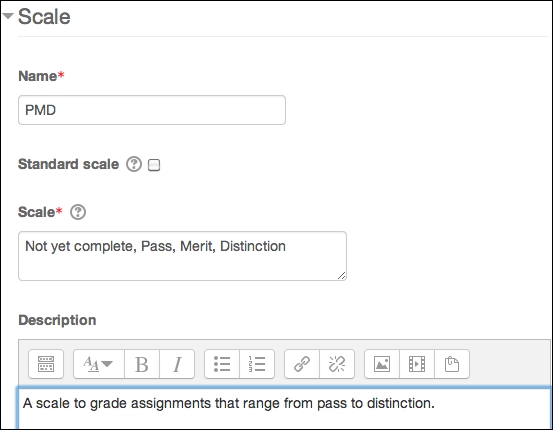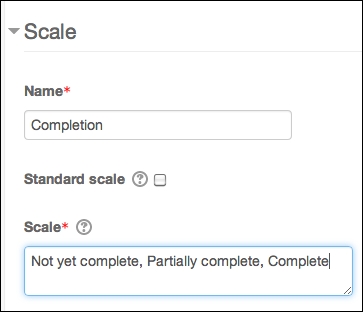Scales are a list of words or characters that can be used to grade assignments. Each scale needs at least two choices, but you can have as many words in the scale as you want. You can also use lots of different scales within one course. Examples of scales include the following:
- Refer or pass
- Unsatisfactory, satisfactory, good, or outstanding
- Reviewed or feedback given
- Fail, pass, merit, or distinction
The scale is created prior to the graded activity being added to the course, and when an activity is added to the course, the required scale can be selected. When marking an assignment, the teacher is given the scale options in a drop-down list so that they can select the grade to be awarded. It should be noted that after a scale has been used, it can no longer be edited.
Scales are useful when assignments are assessed using words or phrases or when a course needs to use a range of different grades in order to provide feedback to learners (as we are only able to have one set of letter grades per course). Scales can be used in a range of contexts, including the use of academic terminology as a grade (such as Pass or Complete) or the use of descriptive text to give useful feedback (such as work reviewed or please speak to your teacher).
Scales can still be used to calculate final grades, but the scores are based on the number of items in the scale rather than a specific score for each element of the scale. Think about a scale that contains two options: Not yet complete and complete. In this example, the scale will be based on a maximum score of 2 (one point for Not yet complete and two points for Complete). However, additional weightings can be used to increase the point value. The use of weightings will be explained in Chapter 5, Using Calculations.
Calculating scores using scales can be confusing and therefore, scales are not always the best option when complex scoring is required. However, for courses that use simple calculations or where there is a point at which a learner will pass, scales can be a useful way to present course grades that will make sense to students.
In the example used earlier, we used Not yet complete, pass, merit, and distinction as grade letters, but this could also easily be added as a word scale. We will set this one up as a scale to see how the scoring will be different:
- Within the course, navigate to Administration | Site administration | Grades.
- Once you're in the Grades area, you will either see a drop-down list or tabs (or both). If you're using the drop-down list, navigate to Scales | View. If you're using the tabs, click on Scales.
- At the bottom of this screen, click on Add a new scale.
- In the Name box, give the Scale option a title. In this case, give it the name
PMDin order to identify it as pass, merit, and distinction. This name is used when you choose to use the scale, so it needs to be easy to identify and differentiate it from any other available scales.In the Scale box, we will write each word that we would like to appear in the grading list, each one separated by a comma. It needs to start with the negative scale item first and end with a positive scale item (that is, the first scale item should be the lowest grade with each scale item increasing and the final scale item as the highest grade). For this example, complete the Scale box, as shown in the following screenshot:

- In the Description box, provide a brief explanation of the scale and/or its use. This is particularly important for standard (site-wide) scales, as teachers might choose to use it even though they haven't created it themselves.
- Click on Save changes to save this scale. It is now available for use.
We will look at how this will be scored when we look at category aggregation in Chapter 5, Using Calculations. However, it will use one of the two grading profiles:
|
Not yet complete |
Pass |
Merit |
Distinction |
|---|---|---|---|
|
0 |
1 |
2 |
3 |
|
1 |
2 |
3 |
4 |
You can see how this will be calculated in a way that is different from the letter grade percentages used earlier.

